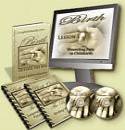Avoiding Episiotomy
There are many simple solutions to avoiding episiotomy which is warranted in less than 10% of births. Currently, 1 in 3 American women has an episiotomy. It is among the most common surgeries performed in the US. Over 1 million unnecessary episiotomies are performed annually.
The first course of action is to discuss what measures your care provider employs for avoiding episiotomy. Find out the percentage of births episiotomies are performed and under what circumstances. "Not very often" is not an acceptable answer. If your care provider is evasive, he may practice episiotomy as a routine procedure, especially for first-time mothers. If you can't get a straight answer and you are planning a hospital birth, the hospital should be able to provide statistics on the number of episiotomies performed as it is in the public domain.
If your care provider used episiotomy as a routine procedure, you can discuss your desire to avoid it and gently remind them that the American Academy of Obstetrics and Gynecology (ACOG) does not support the routine use of episiotomy. Your care provider's support is vital to helping you avoid episiotomy.
After securing your care provider' support, the best options for avoiding episiotomy are using good perineal support measures before and during birth. These include:
PERINEAL MASSAGE
Perineal massage assist the mother in learning to relax rather than tense muscles during crowning and it lets the tissues become more flexible and can prevent tearing.
How to Perform Perineal Massage
- Wash hands thoroughly
- Trim nails to remove sharp edges.
- Apply the lubricant of your choice to the perineum (olive oil, KY jelly, sweet almond oil, vitamin E, etc.)
- Place the thumbs into the base of the vagina up to the first joint, making sure they are well lubricated.
- Using gentle but firm pressure, move the thumbs from the base of the vagina up the side walls as if you were making a "U", but remembering to avoid the urethra.
- As you feel a tingle or stretching, hold the position until it subsides and then continue upward.
- Return the thumbs to the base of the vagina and repeat.
KEGEL EXERCISES
- Kegel exercises are also effective at developing awareness of birthing muscles and in preserving the integrity of the pelvic floor. They were originally developed by Dr. Arnold Kegel in 1948 to improve incontinence in women after childbirth by strengthening the pubococcygeus or "PC" muscles.
- These exercises are not recommended for avoiding episiotomy if you already have urinary stress incontinence.
- It can be taxing to identify and isolate the muscles of the pelvic floor. Particular care must be given to only contract the PC muscles rather than the abdominal or thigh muscles.
PERFORMING PELVIC FLOOR EXERCISES:
1. Empty your bladder.2. While exhaling, tighten the pelvic floor muscles.
3. Hold for a count of 10. Relax for a count of 10.
4. Perform 10 repetitions three times daily.
These pelvic exercises can be performed any time and any place. Many women will perform them as part of their perineal massage routine. It may take 4 to 6 weeks to see improvement; so the earlier you begin, the better. As you become more proficient, you may want to start varying the duration and intensity of the PC squeezing from a long hold to many short bursts.
SELF-DIRECTED PUSHING
- Pushing flat on your back stresses the perineum and narrows the pelvic outlet as much as 30%. Directed or “purple pushing” where you are flat on your back with nurses holding your legs as someone arbitrarily counts to 10 and tells you to hold your breath is quite possibly the WORST thing you can do while birthing. It makes absolutely no sense at all. It is called “purple pushing” because if you do as you are told, you will indeed turn purple from the strain.
- The best way to push is to follow the urge yourself and to be in any position other than flat on your back. Remember the contraction is to do the work of pushing your baby out. You truly don't need to add much extra effort.
PERINEAL SUPPORT for Avoiding Episiotomy DURING BIRTH (HOT/COLD COMPRESSES)
- Using hot compresses on the perineum during crowning can help the tissues stretch as well as helping you stay relaxed.
- Cold compresses can reduce swelling and provide numbing to the perineum.
- Manual support can be provided by your care provider directly on the perineum as the baby crowns. Perineal support can be applied with oil to promote slow stretching of the tissues.
- The baby should be allowed to slowly descend until you feel the uncontrollable urge to push. Full dilation does not necessarily mean that you need to start pushing. Follow your body to decide when it is time for you to push.
In your birth plan, you can specifically state that you insist on avoiding episiotomy. If one becomes medically indicated, you can request a pressure episiotomy. This is done as the baby's head is crowning and the perineal tissues are slowly stretched. It usually allows for a smaller incision that heals better with less stitching. Also, the pressure exerted by the baby's head has a numbing effect, so you may not feel a thing even without a local anesthetic.
REFERENCES
Carroli G, Belizan J. Episiotomy for vaginal birth. Cochrane Database of Systematic Reviews 1999, Issue 3. Art. No.: CD000081. DOI: 10.1002/14651858.CD000081.Beckmann MM, Garrett AJ. Antenatal perineal massage for reducing perineal trauma. Cochrane Database of Systematic Reviews 2006, Issue 1. Art. No.: CD005123. DOI: 10.1002/14651858.CD005123.pub2.
Kettle C, Hills RK, Ismail KMK. Continuous versus interrupted sutures for repair of episiotomy or second degree tears. Cochrane Database of Systematic Reviews 2007, Issue 4. Art. No.: CD000947. DOI: 10.1002/14651858.CD000947.pub2.
Hedayati H, Parsons J, Crowther CA. Topically applied anaesthetics for treating perineal pain after childbirth. Cochrane Database of Systematic Reviews 2005, Issue 2. Art. No.: CD004223. DOI: 10.1002/14651858.CD004223.pub2.
Return from Avoiding Episiotomy to Pregnancy Questions
Return to Giving Birth Naturally Home
Page Last Modified by Catherine Beier, MS, CBE
Most Popular
How to Use Acupressure to Induce Labor
Childbirth Relaxation Script MP3s
Nutrition During Pregnancy - Nix the Notion of Eating for Two
Looking for a Birth Professional? Search our Provider Directory
Online Childbirth Classes
Choose 7 week, 12 week, or Self- Paced online childbirth classes available wherever and whenever you need them.
Featured Birth Story
Vanessa's natural birth story shows that when birth is left alone to proceed as it should, it waits for no one - not even doctors or midwives.
Free Pregnancy Tickers
Create a free pregnancy ticker to post on your blog, website, Facebook profile or favorite social media...




